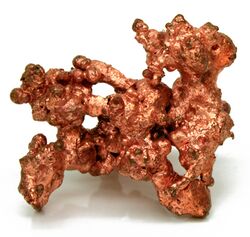Template:Infobox copper
From HandWiki
 | ||||||||||||||||||||||||||||
| Copper | ||||||||||||||||||||||||||||
|---|---|---|---|---|---|---|---|---|---|---|---|---|---|---|---|---|---|---|---|---|---|---|---|---|---|---|---|---|
| Appearance | red-orange metallic luster | |||||||||||||||||||||||||||
| Standard atomic weight Ar, std(Cu) | 63.546(3)[1] | |||||||||||||||||||||||||||
| Copper in the periodic table | ||||||||||||||||||||||||||||
| ||||||||||||||||||||||||||||
| Atomic number (Z) | 29 | |||||||||||||||||||||||||||
| Group | group 11 | |||||||||||||||||||||||||||
| Period | period 4 | |||||||||||||||||||||||||||
| Block | d-block | |||||||||||||||||||||||||||
| Element category | d-block | |||||||||||||||||||||||||||
| Electron configuration | [Ar] 3d10 4s1 | |||||||||||||||||||||||||||
| Electrons per shell | 2, 8, 18, 1 | |||||||||||||||||||||||||||
| Physical properties | ||||||||||||||||||||||||||||
| Phase at STP | solid | |||||||||||||||||||||||||||
| Melting point | 1357.77 K (1084.62 °C, 1984.32 °F) | |||||||||||||||||||||||||||
| Boiling point | 2835 K (2562 °C, 4643 °F) | |||||||||||||||||||||||||||
| Density (near r.t.) | 8.96 g/cm3 | |||||||||||||||||||||||||||
| when liquid (at m.p.) | 8.02 g/cm3 | |||||||||||||||||||||||||||
| Heat of fusion | 13.26 kJ/mol | |||||||||||||||||||||||||||
| Heat of vaporization | 300.4 kJ/mol | |||||||||||||||||||||||||||
| Molar heat capacity | 24.440 J/(mol·K) | |||||||||||||||||||||||||||
Vapor pressure
| ||||||||||||||||||||||||||||
| Atomic properties | ||||||||||||||||||||||||||||
| Oxidation states | −2, 0,[2] +1, +2, +3, +4 (a mildly basic oxide) | |||||||||||||||||||||||||||
| Electronegativity | Pauling scale: 1.90 | |||||||||||||||||||||||||||
| Ionization energies |
| |||||||||||||||||||||||||||
| Atomic radius | empirical: 128 pm | |||||||||||||||||||||||||||
| Covalent radius | 132±4 pm | |||||||||||||||||||||||||||
| Van der Waals radius | 140 pm | |||||||||||||||||||||||||||
| Spectral lines of copper | ||||||||||||||||||||||||||||
| Other properties | ||||||||||||||||||||||||||||
| Natural occurrence | primordial | |||||||||||||||||||||||||||
| Crystal structure | face-centered cubic (fcc) | |||||||||||||||||||||||||||
| Speed of sound thin rod | (annealed) 3810 m/s (at r.t.) | |||||||||||||||||||||||||||
| Thermal expansion | 16.5 µm/(m·K) (at 25 °C) | |||||||||||||||||||||||||||
| Thermal conductivity | 401 W/(m·K) | |||||||||||||||||||||||||||
| Electrical resistivity | 16.78 nΩ·m (at 20 °C) | |||||||||||||||||||||||||||
| Magnetic ordering | diamagnetic[3] | |||||||||||||||||||||||||||
| Magnetic susceptibility | −5.46·10−6 cm3/mol[4] | |||||||||||||||||||||||||||
| Young's modulus | 110–128 GPa | |||||||||||||||||||||||||||
| Shear modulus | 48 GPa | |||||||||||||||||||||||||||
| Bulk modulus | 140 GPa | |||||||||||||||||||||||||||
| Poisson ratio | 0.34 | |||||||||||||||||||||||||||
| Mohs hardness | 3.0 | |||||||||||||||||||||||||||
| Vickers hardness | 343–369 MPa | |||||||||||||||||||||||||||
| Brinell hardness | 235–878 MPa | |||||||||||||||||||||||||||
| CAS Number | 7440-50-8 | |||||||||||||||||||||||||||
| History | ||||||||||||||||||||||||||||
| Naming | after Cyprus, principal mining place in Roman era (Cyprium) | |||||||||||||||||||||||||||
| Discovery | Middle East (9000 BC) | |||||||||||||||||||||||||||
| Main isotopes of copper | ||||||||||||||||||||||||||||
| ||||||||||||||||||||||||||||
Cu data m.p. cat
| |||||
|---|---|---|---|---|---|
| in | calc from C | diff | report | ref | |
| C | 1084.62 | — | — | ||
| K | 1357.77 | 1357.77 | 0 | ||
| F | 1984.32 | 1984.32 | 0 | ||
| max precision | 2 | ||||
| WD |
|
||||
| input | C: 1084.62, K: 1357.77, F: 1984.32 | ||||
| comment | |||||
Cu data b.p. cat
| |||||
|---|---|---|---|---|---|
| in | calc from C | diff | report | ref | |
| C | 2562 | — | — | ||
| K | 2835 | 2835 | 0 | ||
| F | 4643 | 4644 | -1 | delta | |
| max precision | 0 | ||||
| WD |
|
||||
| input | C: 2562, K: 2835, F: 4643 | ||||
| comment | |||||
| Ni ← |
→ Zn | |
| ||
|
| ||
| [] Data sets read by {{Infobox element}} | |
|---|---|
| Name and identifiers | |
| Top image (caption, alt) | |
| Pronunciation | |
| Category (enwiki) | |
| Standard atomic weight | |
| most stable isotope | |
| Natural occurrence | |
| Phase at STP | |
| Chemistry:Oxidation states | |
| Spectral lines image | |
| Physics:Electron configuration (cmt, ref) | |
| Term symbol * (cmt, ref) | |
| Wikidata * | |
| * Not used in {{Infobox element}} (2019-02-03) See also {{Infobox element/symbol-to--navbox}} | |
References
- ↑ Meija, Juris; Coplen, Tyler B.; Berglund, Michael; Brand, Willi A.; De Bièvre, Paul; Gröning, Manfred; Holden, Norman E.; Irrgeher, Johanna et al. (2016). "Atomic weights of the elements 2013 (IUPAC Technical Report)". Pure and Applied Chemistry 88 (3): 265–91. doi:10.1515/pac-2015-0305.
- ↑ Moret, Marc-Etienne; Zhang, Limei; Peters, Jonas C. (2013). "A Polar Copper–Boron One-Electron σ-Bond". J. Am. Chem. Soc 135 (10): 3792–3795. doi:10.1021/ja4006578. PMID 23418750.
- ↑ Lide, D. R., ed (2005). "Magnetic susceptibility of the elements and inorganic compounds". CRC Handbook of Chemistry and Physics (86th ed.). Boca Raton (FL): CRC Press. ISBN 0-8493-0486-5. https://web.archive.org/web/20110303222309/http://www-d0.fnal.gov/hardware/cal/lvps_info/engineering/elementmagn.pdf.
- ↑ Weast, Robert (1984). CRC, Handbook of Chemistry and Physics. Boca Raton, Florida: Chemical Rubber Company Publishing. pp. E110. ISBN 0-8493-0464-4.

